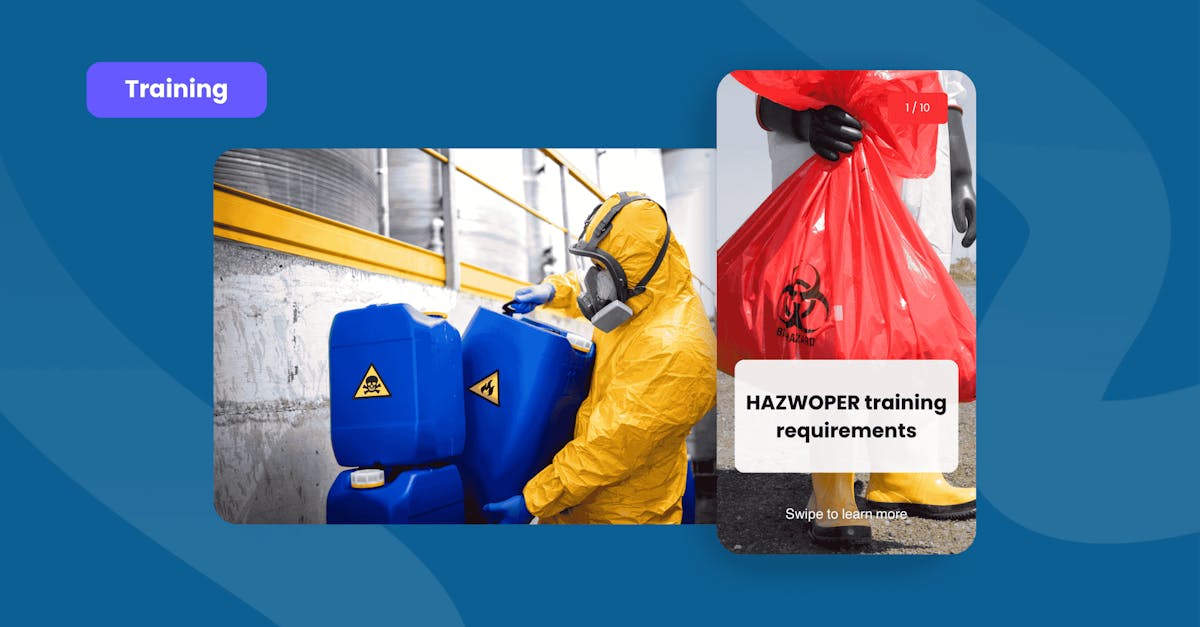HAZWOPER training requirements to maintain compliance

Even with quality preventive measures in place, emergencies cannot be completely avoided in high-risk industries like manufacturing, construction, and waste management. With no proper training, your team will have a hard time doing damage control when they find themselves in a tight spot.
Organizations like the Occupational Safety and Health Administration (OSHA) have strict regulations in place to protect workers from workplace accidents. Failure to follow OSHA standards can result in legal penalties that may be costly to the business.
What is HAZWOPER?
HAZWOPER stands for Hazardous Waste Operations and Emergency Response. It refers to the OSHA regulations under 29 CFR Part 1910.120 that establish how to properly handle hazardous waste and respond to related emergencies.
HAZWOPER training tackles key topics that address these regulations so you can help your team safely manage hazardous waste and substances on the job:
- Hazard identification: How to spot hazards and foresee potential risks if they’re not removed or controlled.
- Personal protective equipment (PPE) usage: Proper wearing of PPE to reliably prevent injuries or minimize exposure to hazardous waste.
- Emergency response: Essential crisis management techniques like first aid and evacuation procedures can help minimize damage in the event of an accident.
- Site safety plans: Developing plans and policies to make sure that identified hazards are controlled or removed.
- Regulations and compliance: OSHA regulations that your team must follow consistently to avoid legal fees and reputational damage.
SC Training has curated a list of HAZWOPER training courses to help familiarize your team with hazardous waste management practices. It features notable safety officer courses compliant with OSHA’s HAZWOPER training requirements, keeping your team’s knowledge up to par with industry standards.
What are the requirements for HAZWOPER training?
To maintain workplace safety, OSHA lists the following HAZWOPER training requirements for anyone working with hazardous waste and substances:
1. Initial training
New team members who haven’t completed any accredited HAZWOPER training must complete either a 40-hour or 24-hour course. What they’ll take will be largely dependent on their level of exposure to hazardous substances when they’re at work.
- 40-hour training: Workers who regularly handle or are directly exposed to hazardous waste at work have to take the 40-hour HAZWOPER training. To get a valid OSHA HAZWOPER certification, they’re also required to take one to three days of supervised field training upon completing the 40-hour course.
- 24-hour training: those who have minimal and indirect exposure to hazardous waste can take the 24-hour HAZWOPER training instead. This includes blue-collar and utilities workers who report to work environments that may be contaminated with hazardous waste residues.
2. Annual refresher training
Employees have to complete a HAZWOPER refresher course at least once every year to stay up-to-date. The course must cover 8 hours' worth of HAZWOPER topics to pass OSHA’s requirements.
3. Job-specific training
Site-specific training assigned by employers should also be completed to cover safety practices and protocols that directly address workplace hazards unique to the job. This must be well-documented and updated, as it aims to prepare them for real-life scenarios they’ll encounter as they work.
Emergency responders could benefit from HAZWOPER training focused on developing, understanding, and implementing emergency response procedures (ERPs). On the other hand, clean-up crews might find HAZWOPER training on environmental sampling and air monitoring more relevant to their role.
Who needs HAZWOPER training?
HAZWOPER training should be taken regardless of their level of exposure. There are manufacturing roles that directly handle hazardous waste, while others are indirectly exposed, but both groups could benefit from HAZWOPER training.
Roles with direct exposure:
- Chemical manufacturing workers who handle or produce hazardous substances directly in their processes
- Plastics production workers who might engage in cleanup or spill response
- Laboratory staff who test raw materials and components for hazardous waste
- Waste handlers or technicians who manage hazardous byproducts in manufacturing facilities
Roles with indirect exposure:
- Industrial hygienists who conduct inspections and site assessments that expose them to hazardous residues
- Maintenance workers and technicians who work in potentially contaminated environments
- Equipment operators involved in manufacturing stages that risk inhalation of hazardous dust, vapors, and fumes
How often does OSHA require HAZWOPER training?
Teams are required to accomplish their HAZWOPER training yearly from the moment they receive their initial certification. Putting it off for too long might require them to retake their initial training at the employer’s discretion.
Hazard communication standards are often updated to align with the UN Globally Harmonized System (GHS). Meanwhile, standards on PPE usage are regularly revised to address findings from recent risk assessments. Offering refresher courses for your team gives them access to the most recent and relevant OSHA safety tips.
What are the different HAZWOPER training levels?
HAZWOPER training is divided into different levels to make sure teams learn safety procedures that are relevant to their roles and responsibilities. This also prevents over-training and under-training, helping you maximize the cost-effectiveness of your HAZWOPER training.
1. First responder awareness level
Workers trained at this level must know what hazardous substances are and their associated risks. They’re tasked with reporting emergencies to authorities and initiating a response. This is where their responsibility ends; they’re not allowed to do anything else beyond notifying authorities.
Their key role in emergency response also requires them to be familiar with the US Department of Transportation’s Emergency Response Guidebook. They must understand their role in site security and control.
2. First responder operations level
People under this level respond to the report created at the first responder awareness level. Their primary role is to protect people, property, and the environment from the negative effects of hazardous substances released. However, their goal is not to stop the release, but to control it from a distance and minimize exposure.
Given these responsibilities, they must be trained in skills such as risk assessment techniques, decontamination and termination procedures, and PPE use. They must have completed at least eight hours of HAZWOPER training or sufficient experience showing their abilities in key containment and response protocols.
3. Hazardous materials technician
If the operational first responders are only meant to control the release from afar, hazardous materials technicians are the ones who step in to stop it. They take on a more dangerous role, approaching the source of the release and patching or plugging it.
Because of the higher risk associated with this level, hazardous materials technicians are required to complete a 24-hour HAZWOPER training similar to the previous level. On top of this, they must be trained to use field survey equipment to classify materials and utilize chemical PPE.
Simply pulling a plug or closing a lid can pose serious risks if your technician lacks proper training. As such, a basic understanding of chemical and toxicological terminology and their behavior is essential to address the consequences of stopping a release.
4. Hazardous materials specialist
Hazardous materials specialists carry similar responsibilities to hazardous materials technicians. However, the specialist has more technical knowledge of the particular substances they’re assigned to contain. This equips them to deal with more complex chemical hazards.
The specialist also acts as the primary point of contact with federal, state, local, and other government authorities when it comes to site activities. They’re required to complete 24 hours of HAZWOPER training on the technician level, with additional knowledge on specialized topics.
A hazardous materials specialist requires a higher level of technical expertise. They’re involved with strategically planning response plans, managing the team’s regulatory compliance, and maintaining team coordination against hazardous waste.
5. On-scene incident commander
On-scene incident commanders are tasked with managing emergencies overall. They’re responsible for developing preventative measures and properly implementing them on the site.
Most commanders take 40 hours of training, given the significance of their role. However, a minimum of 24 hours’ worth of training equal to the first responder operations level is required of them.
As per the HAZWOPER training requirements outlined by OSHA, they must understand and implement the employer’s incident command system. Plus, they must demonstrate a thorough comprehension of the Federal Regional Response team’s state emergency response plan.
You can look into HAZWOPER training levels in more detail by visiting OSHA’s official website. They have a dedicated HAZWOPER page that covers the required knowledge and skills for each level.
Refresh your team’s HAZWOPER training knowledge with SC Training
HAZWOPER training involves a large amount of information for your team to digest. This makes it overwhelming for them to finish their training, putting them at risk of violating compliance standards.
SC Training’s HAZWOPER courses are bundled together with engaging features built for recall. This makes sure your team will be oriented on OSHA safety tips the right way.
- Microlearning: Reduce burnout, prevent information overload, and increase retention by breaking up your training into bite-sized lessons that are easier to digest.
- Reporting and analytics: Keep track of who’s completed their refresher training and make sure your team stays compliant with OSHA’s annual requirement.
- Briefcase: SC Training offers multiple ways to discuss topics. Whether through video, images, or a preview of official documents, your team can learn the material with supporting media that boosts their retention.
Author
Shan Jose
Shan Jose is a content specialist for SC Training, a learning management system that provides microlearning solutions for businesses and organizations. Her work offers SaaS solutions and practical advice to enhance workplace and compliance training, boosting training effectiveness and meeting essential requirements. Outside of work, she enjoys singing, playing story-driven video games, and spending time with friends and family.
